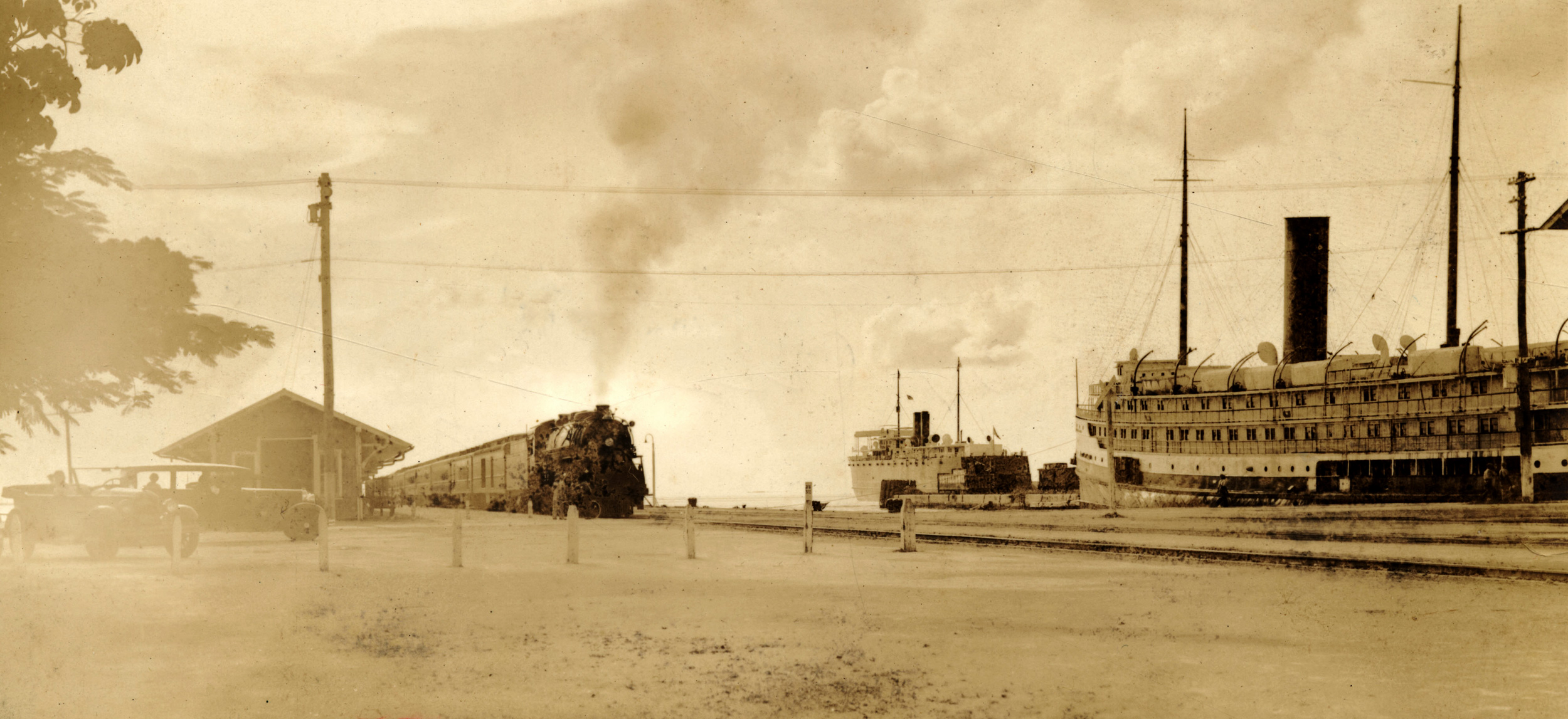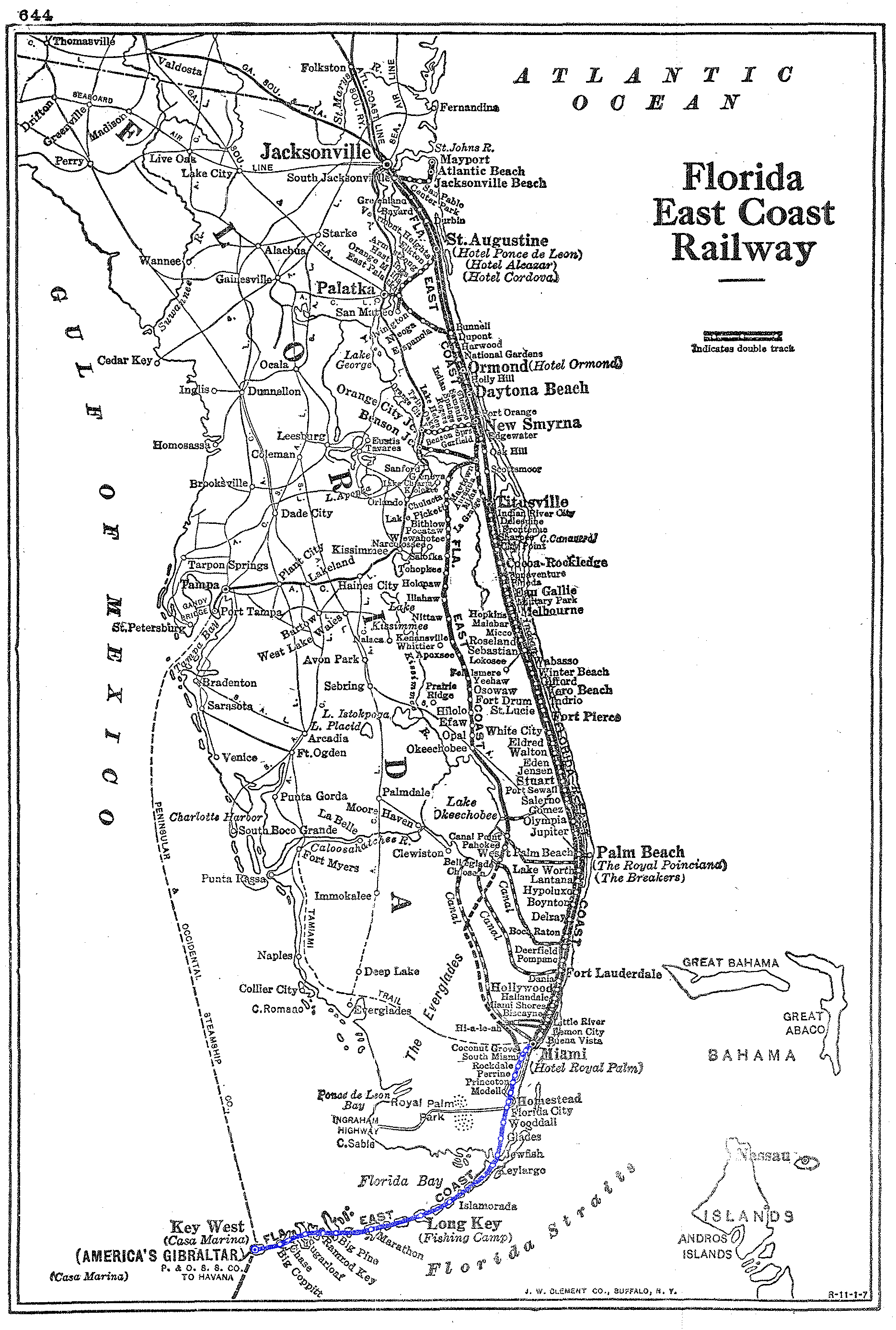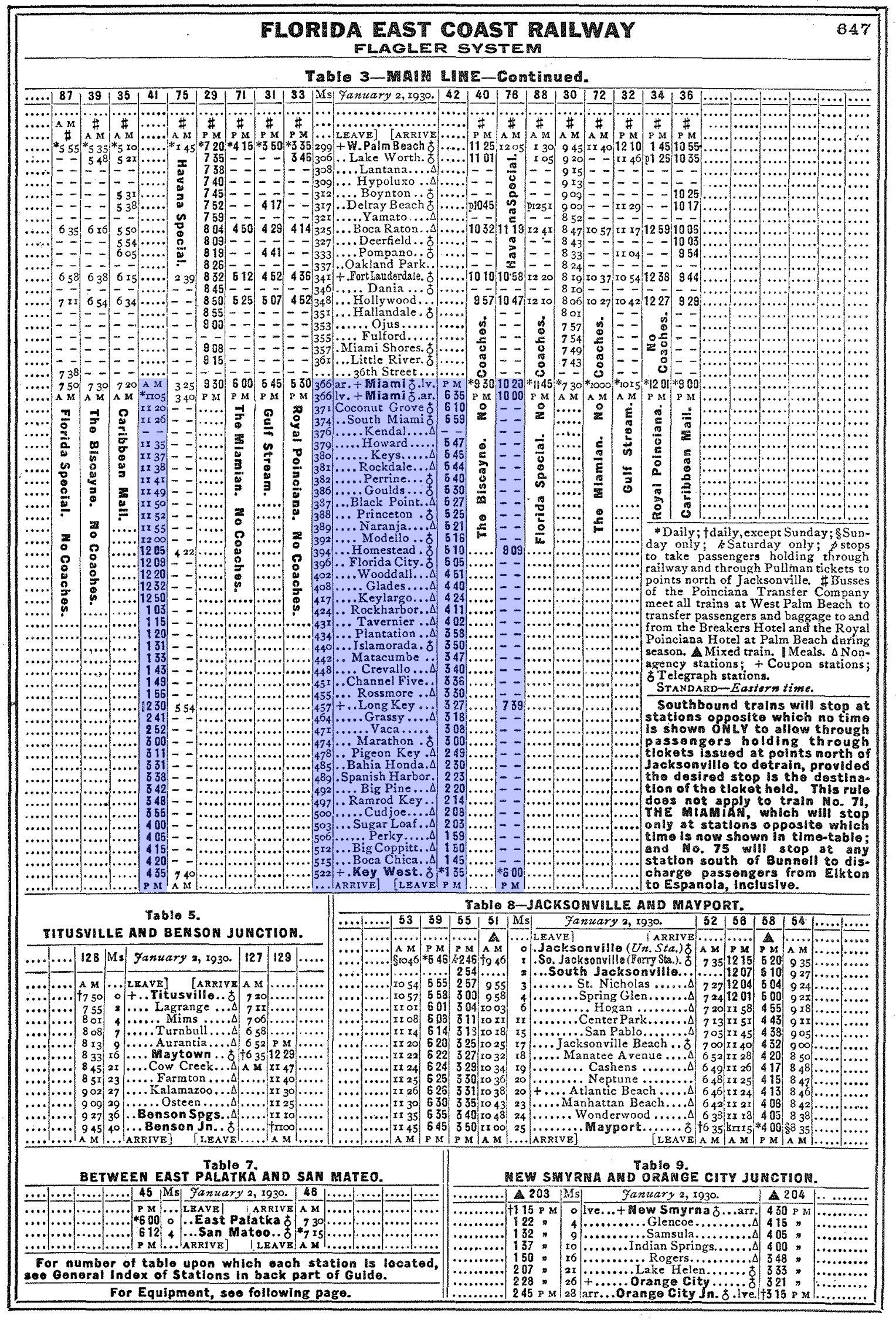Key West Extension (Overseas Railroad)
Last revised: October 11, 2023
By: Adam Burns
The Overseas Railroad, also known as the "Key West Extension," was an extension of the Florida East Coast Railway linking its main line at Miami to Key West, a city located on an island at the southernmost tip of Florida.
Constructed between 1905 and 1912 by Henry Flagler, the railroad was a significant engineering feat, stretching over 128 miles of open water and islands in the Atlantic Ocean and Gulf of Mexico.
However, it was severely damaged in the 1935 "Labor Day Hurricane" and subsequently abandoned. After its conversion into the Overseas Highway some of the former causeways and trestles have since been converted into pedestrian walkways.
 One of the great photos of the Key West Extension as what appears to be a 4-8-2 Mountain is ready to leave from the FEC's main terminal at Trumbo Island in Key West during a late afternoon in 1933.
One of the great photos of the Key West Extension as what appears to be a 4-8-2 Mountain is ready to leave from the FEC's main terminal at Trumbo Island in Key West during a late afternoon in 1933.Overview
The legend of the Florida East Coast was cemented when its leader, Henry Flagler, took his railroad to sea in 1905. The mogul, who made his millions in oil alongside John D. Rockefeller and Standard Oil, had high hopes for what became the Florida Overseas Railroad - better known as the Key West Extension.
By the early 20th century, the FEC had not only singlehandedly developed Florida's Atlantic coastline into a vacation paradise for which it is still known today but also offered the only rail service along the state's East Coast.
Despite its monumental expense and impressive nature, the Florida Overseas Railroad never blossomed into the great extension Flagler had envisioned.
The city of Key West's deep water port failed to develop into either a major generator of freight or a coal refueling point for marine vessels.
After struggling for two decades, one of the railroad industry's most celebrated accomplishments was destroyed by the Labor Day Hurricane of 1935.
At A Glance
The then-bankrupt FEC could not afford repairs to the line and, as a result, the property was sold to the state of Florida, which converted the former railbed into Keys' first highway.
What became the Overseas Highway (U.S. 1), the route still serves Key West today albeit the former rail bridges no longer carry vehicle traffic.
It is always fun to daydream what could have been with the Key West Extension. There is no question if the line was still active it would be an incredible tourist attraction drawing thousands annually.
However, it was built as a freight corridor and, unfortunately, Key West never materialized into the deep water port Henry Flagler had envisioned. The extension was already in decline when the Labor Day Hurricane struck in 1935 and would almost certainly have been abandoned at a later date.
History
Henry Flagler began his rail empire in 1885 when he acquired a rickety, 36-mile narrow-gauge property known as the Jacksonville, St. Augustine & Halifax River Railway (JStA&HR).
As George Hilton points out in his book, "American Narrow Gauge Railroads," the JStA&HR was a disconnected system from the national rail network at the time. It ran southeasterly from South Jacksonville and reached St. Augustine.
The road also had a connection with the little Jacksonville & Atlantic Railway which ran due east to Pablo Beach. Flagler quickly converted the JStA&HR to standard gauge and then set about expanding his growing rail network southward, once a direct rail connection was established across the St. Johns River (1890).
More about the history of the Florida East Coast, its growth, and impact on its home state can be found here. Suffice it to say, by the turn of the 20th century, Flagler had built not only built Florida into a growing prosperous destination but also created a highly profitable railroad in the process.
The Key West Extension, officially known as the Overseas Railroad, was the final leg of Flagler's great railroad empire.
The monumental effort took an immense amount of time and resources, spanning over seven years before the railroad was officially unveiled and operational. Attesting to the sheer scale of the project, the precise cost to build the Overseas Railroad was a staggering $49 million - a monumental sum for that era.
The key financier behind this ambitious project was none other than the visionary Henry Flagler himself. His wealth and propensity for infrastructural advancement were the driving forces behind realizing this dream of an overseas railroad.
Map (1930)
Construction
Flagler believed Key West would develop into a busy deep water port (then containing about 20,000 residents) as well as a trade route with Cuba and Latin America following the Panama Canal's opening (then under construction).
He also felt the port would act as a vital refueling (coal) point for steam ships entering or exiting the canal. Following a series of surveys, company engineers concluded a railroad could, indeed be constructed across the Keys and into Key West.
The railroad made an official announcement construction of the project had commenced in April, 1905. The line had already reached Homestead a year earlier in 1904 and proceeded steadily southward after that time. By late 1905 work was underway from both directions.
Bridges
The spans presented in the below table are those located south of Homestead, Florida.
| Name | Milepost | Length |
|---|---|---|
| Jewfish Creek Bridge | 417 | 233 Feet |
| Indian Key Draw Bridge* | 445 | - |
| Channel #2 Bridge | 450.1 | 1,721 Feet |
| Channel #5 Draw Bridge | 451.3 | 4,520 Feet (2.69 Miles) |
| Long Key Viaduct | 457.4 | 14,190 Feet |
| Toms Harbor Viaduct #4 | 462.2 | 1,397 Feet |
| Knight's Key Bridge | 467.1 | 35,711 Feet (6.76 Miles) |
| Moser Channel Rotating Swing Bridge | 479 | - |
| Little Duck Missouri Viaduct | 483.3 | 800 Feet |
| Missouri-Ohio Viaduct | 483.7 | 1,395 Feet |
| Ohio Bahia Honda Bridge | 484.4 | 1,005 Feet |
| Bahia Honda Bridge | 486.8 | 5,005 Feet |
| Spanish Harbor Viaduct | 489.3 | 3,312 Feet |
| Pine Channel North Viaduct | 493.5 | 622 Feet |
| Pine Channel South Viaduct | 494.2 | 808 Feet |
| Torch Key Viaduct #1 Bridge | 495.0 | 799 Feet |
| Torch Ramrod Viaduct | 495.4 | 616 Feet |
| Niles Channel Viaduct | 496.7 | 4,435 Feet |
| Kemp Channel Viaduct | 499.3 | 933 Feet |
| Bow Channel Viaduct | 502.6 | 1,303 Feet |
| Park Key Viaduct | 504.3 | 779 Feet |
| North Harris Viaduct | 505.2 | 390 Feet |
| South Harris Viaduct | 506.5 | 390 Feet |
| Lower Sugar Loaf Viaduct | 507.5 | 1,212 Feet |
| Saddle Bunch Viaduct #2 Bridge | 508.4 | 552 Feet |
| Saddle Bunch Viaduct #3 Bridge | 508.7 | 656 Feet |
| Saddle Bunch Viaduct #4 Bridge | 509.8 | 801 Feet |
| Saddle Bunch Viaduct #5 Bridge | 510.3 | 805 Feet |
| Sharks Key Viaduct | 511.3 | 1,989 Feet |
| Rockland Viaduct | 513.2 | 1,231 Feet |
| Boca Chica Viaduct | 516.4 | 2,573 Feet |
| Garrison Bight Draw Bridge | 521 | 159 Feet |
* Removed and replaced with solid fill in 1916.
The extension covered a total of 156 miles via Miami. The elderly Flagler nearly bet everything on the railroad's gamble to reach Key West. The project coursed through an intricate network of islands, literally bridging gaps between the Florida Peninsula and the majestic Florida Keys.
From Miami, it stretched southwards, winding through a chain of islands including Key Largo, Islamorada, Marathon, Bahia Honda, and finally terminating at Key West.
The Overseas Railroad was built to the highest construction standards, often utilizing concrete viaducts to bridge the distances across the tiny patches of land. At one time or another the company employed more than 4,000 men.
The extension required more than two-dozen bridges to reach Key West with the longest structure the Seven Mile Bridge, connecting Marathon with Big Pine Key. It took Flagler and the FEC seven years to complete the Extension with the route officially opening on January 21, 1912.
A day later the 82-year-old Flagler rode the entire line to Key West aboard his private business car. Most had scoffed at the idea that such a railroad could be built initially calling the extension "Flagler's Folly". However, once completed it was hailed at the time as the "Eighth Wonder of the World". Overall the project had cost $49 million.
Unfortunately, the Extension never reached its full potential. Despite Flagler's belief that Key West would become a major port for trade with Cuba, Latin, and South America this never materialized.
And, neither did the hope of Key West becoming an important refueling stop for ships. As sailing vessels were able to travel further and further without the need to refuel, the resort town lost its status as a maritime resupply hub. In addition, diesel would soon replace coal as the world's primary source of fuel.
Timetable (1930)
Labor Day Hurricane (1935)
Then, the category five Labor Day Hurricane of 1935 devastated the Keys and the Florida Overseas Railroad killing more than 400 people, overturning the train dispatched to evacuate folks off the islands, and wrecking the extension. To see a collection of historic photographs please click here.
U.S. 1 Highway
With the FEC already in bankruptcy the railroad was unable to afford repairs to the route. Although the railroad’s demise was unfortunate, its legacy lived on.
The State of Florida purchased the remaining right-of-way and salvageable railway infrastructure for $640,000, transitioning it into what is now known as the Overseas Highway (U.S. Route 1), a critical transportation link still serving the Keys to this day.
The original railroad
bridges remained in use carrying vehicular traffic until the 1980s when
the state began constructing new bridges to serve the islands. However,
today, these original structures remain in place and mostly used
as fishing or walking piers and are listed on the National Register of Historic Places.
Legacy
Today, the Florida Overseas Railroad's remnants interspersed along the Overseas Highway serve as a stirring reminder of a monumental period in transportation history, symbolizing unbounded ambition, challenging yet fruitful execution, and eventual reinvention post-destruction.
In summaries, the "Overseas Railroad", also known as the “Key West Extension”, "remains one of the most audacious feats of railroad engineering.
Its story, marked by a beginning filled with optimistic ambition, flourishing years of operation, and an abrupt end brought on by the devastating 1935 Labor Day Hurricane, continues to inspire and inform, serving as a case study of immense entrepreneurial courage and transformative urban development.
The railroad's physical and symbolic manifestations stir a sense of courage, resilience, and the ability to navigate seemingly insurmountable challenges. It stands as a testament to human ingenuity and perseverance.
Its existence was monumental, not merely as a transportation link but as a symbol of infrastructural innovation and economic growth.
Despite its demise, the Overseas Railroad left an indelible mark on the state of Florida and the nation’s transportation history. To this day, relics of the railroad exist as bridges within the Overseas Highway, monuments to a bold past transformed into the arteries of present-day travel and transport.
By investing large amounts of his wealth into an unprecedented infrastructural development like the Overseas Railroad, Flagler showcased a unique blend of unflinching ambition, risk-taking, and incredible foresight.
Today, we can only estimate the daring vision that drove Flagler and his team to take on such a challenging and Herculean task. Despite its operational halt post the destructive 1935 Labor Day Hurricane, the Florida Overseas Railroad's legacy has survived through adaptability and innovation.
Its transformation into the Overseas Highway speaks volumes about the utility and significance of the rail lines and their eventual repurposing into a major roadway.
The railroad speaks to the massive financial risk, the relentless pursuit, and the ultimate realization of a dream despite the obstacles, emphasizing the possible when vision is coupled with persistent action.
As a testament to human ingenuity and adaptability in the face of adversities, the Overseas Railroad represents an enduring symbol of Florida’s economic and social evolution.
In conclusion, the Florida Overseas Railroad is a poignant slice of American history that bridges our past and present, reminding us of the boundless potential when inventive engineering, audacious vision, and persistent commitment combine. Its remnants and memories continue to inspire, serving as a tangible testament to an era of daring feats and transformative infrastructural developments.
Sources
- Bramson, Seth H. Greatest Railroad Story Ever Told, The: Henry Flagler & The Florida East Coast Railway's Key West Extension. Charleston: The History Press, 2011.
- Bramson, Seth H. Speedway To Sunshine, The Story Of The Florida East Coast Railway. Charleston: Boston Mills Press, 1984, 2010.
- Hilton, George. American Narrow Gauge Railroads. Stanford: Stanford University Press, 1990.
Contents
SteamLocomotive.com
Wes Barris's SteamLocomotive.com is simply the best web resource on the study of steam locomotives.
It is difficult to truly articulate just how much material can be found at this website.
It is quite staggering and a must visit!


